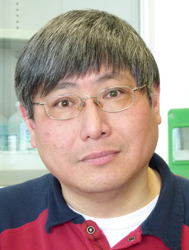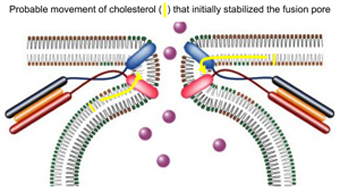Fred Tse
Dr Frederick W Tse
Professor
Education:
BSc (Zoology), University of Toronto, 1980
MSc (Zoology), University of Toronto, 1981
PhD (Physiology), University of Toronto, 1987
Teaching: PMCOL371, PMCOL442, PMCOL416*, PMCOL512
Research: Control of Exocytosis and Cellular Excitation-Secretion Coupling
Research Interests / Laboratory Techniques
My lab is focused on the control of exocytosis and endocytosis: the process of fusion and fission of small vesicles with the surface (plasma) membrane of the cell. These processes regulate not only the secretion of neurotransmitters, hormones and cellular mediators that are packaged into secretory vesicles, but also the size of cells.
We have been employing a combination of biophysical approaches to precisely trigger and monitor exocytosis. These approaches include flash photolysis of "cage"-cal cium compounds, membrane capacitance measurement in whole cell mode, detection of catecholamine release from individual vesicles by carbon fiber amperometry and optical imagining of membrane fusion/fission.
cium compounds, membrane capacitance measurement in whole cell mode, detection of catecholamine release from individual vesicles by carbon fiber amperometry and optical imagining of membrane fusion/fission.
We made two recent discoveries.
(1) Unlike neurons and endocrine cells that are specialized for robust secretion of transmitters and hormones respectively, the chemosensory glomus cells (which secretes dopamine as well as other transmitters for local para/autocrine signaling) in the carotid body (located adjacent to each carotid arteries, and is a key sensor of oxygen and carbon dioxide dissolved in the blood) are inefficient in retrieving their secretory vesicles via the process of endocytosis after a robust burst of exocytosis. This phenomenon is correlated with the lower expression of key proteins that are involved in the process of endocytosis.
(2) At chromaffin cells (that secrete the stress hormones, adrenaline and noradrenaline) of the adrenal gland, the hydrolysis of a type of membrane lipid, sphingomyelin, selectively influences one stage of exocytosis when the lumen of a secretory vesicle is just connection to the extracellular space via a very small structure called the fusion pore. This effect involves the redistribution of cholesterol molecules that normally interact tightly with sphingomyelin.
We are extending our recent studies in two angles
(1) We are comparing the relative expression of proteins involved in exo-endocytosis at the two cells models mentioned above.
(2) We plan to examine whether the perturbation of lipids have different effects on exo/endocytosis of cells that are known to have different physiological rates and patterns in their secretory output.
Selected Recent Publications
Lee AK, Tse FW and Tse A. (2015) Arginine vasopressin (AVP) potentiates the stimulatory action of CRH on pituitary corticotropes via a protein kinase C dependent reduction of the background TREK-1 current. Endocrinology 156(10):3661-72. PMID: 26248219.
Tse A, Lee AK, Tse FW. (2013) Influence of arachidonic acid on the endocrine response to stress. In: Arachidonic acid: dietary sources and general functions, Dumancas GG, Murdianti BS, Lucas (Eds.), Nova Science Publishers Inc, NY., Chapter 4, 51-62.
Tse A, Yan L, Lee AK, Tse FW. (2012) Autocrine and paracrine actions of ATP in rat carotid body. Can J Physiol Pharmacol 90(6):705-711. PMID: 22509744.
Wang N, Lee AK, Yan L, Simpson MR, Tse A, Tse FW. (2012) Granule matrix property and rapid "kiss-and-run" exocytosis contribute to the different kinetics of catecholamine release from carotid glomus and adrenal chromaffin cells at matched quantal size. Can J Physiol Pharmacol 90(6):791-801. PMID: 22506963.
Tse A, Lee AK, Yan L, Tse FW. (2012) Influence of cholesterol on cellular signaling and fusion pore kinetics. J Mol Neurosci 48(2):395-401. PMID: 22467040.
Tse A, Lee AK, Tse FW. (2012) Ca2+ signaling and exocytosis in pituitary corticotropes. Cell Calcium 51(3-4):253-259. PMID: 22225940.
Yan L, Lee AK, Tse FW, Tse A. (2012) Ca2+ homeostasis and exocytosis in carotid glomus cells: role of mitochondria. Cell Calcium 51(2):155-163. PMID: 22209034.
Lee AK, Yeung-Yam-Wah V, Tse FW and Tse A (2011) Cholesterol elevation impairs glucose-stimulated Ca(2+) signaling in mouse pancreatic β-cells. Endocrinology 152(9):3351-3361. PMID: 21712366.
Wang, N., Kwan, C., Gong, X., Posse de Chaves, E., Tse, A. & Tse, F.W. (2010) Influence of cholesterol on catecholamine release from the fusion pore of large dense core chromaffin granules. J. Neurosci. 30:3904-3911. PMID: 20237261.
Tse, A., Lee, A.K., Takahashi, N., Gong, A., Kasai, H. & Tse, F.W. (2018) Strong stimulation triggers full fusion exocytosis and very slow endocytosis of the small dense core granules in carotid glomus cells. J Neurogenetics 32, 267-278. DOI:01.1080/01677063.2018.1497629